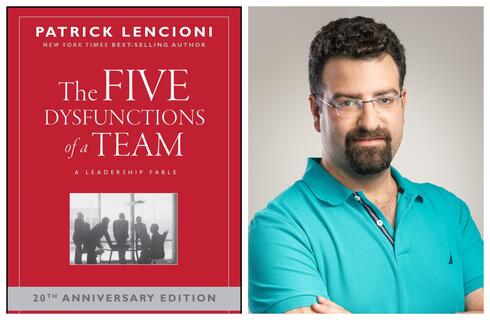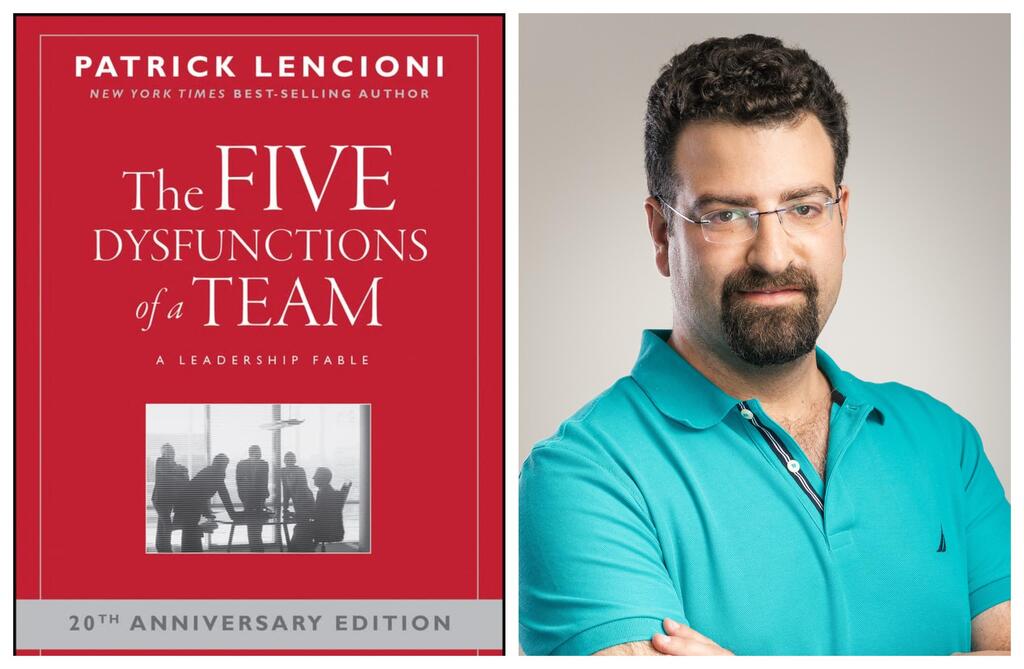
BiblioTech
CTech’s Book Review: building teams that trust each other
Adi Ben-Dayan, Co-Founder and VP R&D at Rewire, has joined CTech to share a review of “The Five Dysfunctions of a Team” by Patrick Lencioni
Adi Ben-Dayan is Co-Founder and VP R&D at Rewire, which provides an online cross-border financial management platform for migrant workers worldwide. He has joined CTech to share a review of “The Five Dysfunctions of a Team” by Patrick Lenioni.
Title: “The Five Dysfunctions of a Team”
Author: Patrick Lencioni
Format: Book
Where: Home
Summary:
The book presents a theoretical company in a less-than-ideal situation that hires a new, female CEO to rehabilitate the organization. At first, her ideas are rejected, but just like any super-strong heroine, she rises to the challenge, and step by step, manages to disassemble the complexities of team relationships, which include ego, distrust and lack of commitment. With a lot of sensitivity, she manages to rebuild the organization into a healthy work environment where trust is key.
Naturally, personas in the book are exaggerated. But, it is still applicable to any team of equals led by a defined leader. So, how do you go from very little trust to full accountability in an existing, dysfunctional organization? Lencioni essentially presents five layers of a dysfunctioning organization while suggesting solutions:
- Absence of trust: The issue of trust mostly refers to having confidence in your equal at another department and their view of the organization as a whole, knowing that both your priorities are aligned and that no one is prioritizing their individual team’s interest over the company’s interest. That way, a healthy exchange of information can be conducted without fear of exposing challenges and even failures.
- Fear of conflict: A healthy environment is built on the ability to create and face conflict. Well-managed conflicts are key to bringing ideas to light and influencing each other’s perspective on how to move forward.
- Lack of commitment: To create commitment, people need to speak up and state their point in front of the group. Once people know that they are heard and that the team understands their point, they would be more inclined to accept and commit to the final decision, even if it contradicts their own opinion.
- Avoidance of accountability: For the leader to not be a bottleneck for processes, team members need to trust and support each other. The hardest part is making the team (and not only its leader) feel comfortable holding each other accountable for their action items. If the team agrees on a certain plan of action and a member of the team doesn’t deliver on what was agreed upon by the team, that individual jeopardizes the team’s ability to win.
- Inattention to results: When the team members are focused on shared, clear, and measurable goals (i.e. company’s KPIs / OKRs), the likelihood of success grows dramatically. Management teams need shared goals for cross-company projects to succeed.
These layers depend on each other. It is hard to have a meaningful, open conflict if the parties don’t trust each other’s motivations and agendas. It is highly unlikely to gain accountability if, to begin with, you didn’t commit to a goal simply because you felt the decision was not “correct.”
Whether you manage a C-level team or any other type of team, establishing each of these steps in your company/group, will increase the likelihood of the team achieving complicated business goals together.
Important themes:
There are a lot of takeaways from this book, but as I see it, the three most important ones are (1) leading by example, (2) identifying the step in which the team I lead is at, and helping them get to the next one, and (3) prioritizing the needs of my peers from across the organization over those of the team I lead.
I’ll explain.
Building a team also builds the leader in the eyes of the team. Built with sensitivity, the person building the team becomes the leader they need; not by telling them what to do but by setting an example. The book also discusses vulnerability as a trait - if I show weakness, is it good or bad? According to Lenioni, it’s good because the secret is to lead by example. One cannot demand openness and trust all while avoiding conflict and not showing vulnerability.
A healthy work environment is a product of nurturing group dynamics. The idea is to see your equals across the organization as your team and not as representatives of their departments, to see the needs of the organization and not the needs of the team within the organization. That way, the team leader gains a wider perspective regarding the organization in a clean manner, free of internal politics.
What I’ve learned:
I’ve learned so much. But, there are four main ideas that I try to apply on my day-to-day with both of the teams I am part of (the one I lead and the one that includes my peers across the organization):
- My people know my weak and strong suits. We speak as equals without any distance or rank politics. Moreover, I ask my team for the exact same things as I ask of myself.
- Trust is key. What happens when a C-level executive is in the middle of a conflict between two departments? How can you back your employee all while looking at the organization as a whole? The higher you are on the organizational chart, the easier it is to have a wider perspective on the needs of the organization. Otherwise, you need to trust that your equal in another department shares your view on the organization’s business goals.
- The leader has an important role - to generate a trusting relationship between the different team members, and between the individual team members to the leader. When leading by example, trust can easily be achieved as the leader is able to demonstrate the type of behaviors he seeks from the team. Showing vulnerability and openly discussing your hardships with your team will lead to a collaborative team that is able to solve issues together.
- Building a team is hard. But once done well, you can enjoy a healthy and harmonious work environment that enables the organization to fulfill its purpose by achieving its goals.
Who should read this book:
Every team and business leader. To be more specific, I would advise anyone who leads a team, even a small one, to read this book as its lessons apply to those who deal with the joys and complexities of leading individuals as a functioning, productive unit. The book especially becomes relevant when leading a heterogeneous team as in diverse teams, trust is often more difficult to establish.














